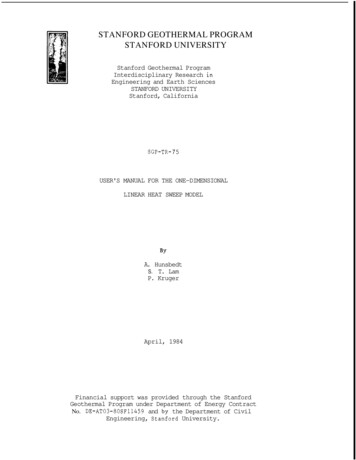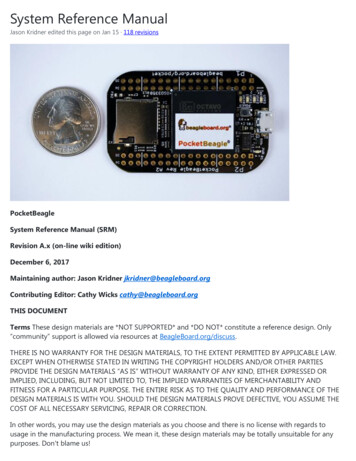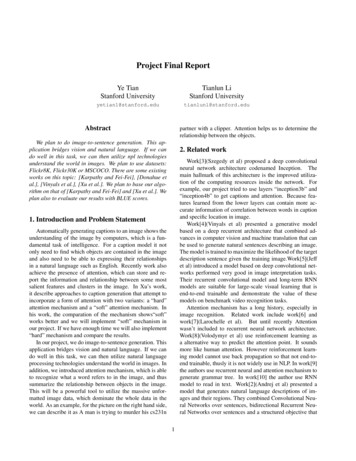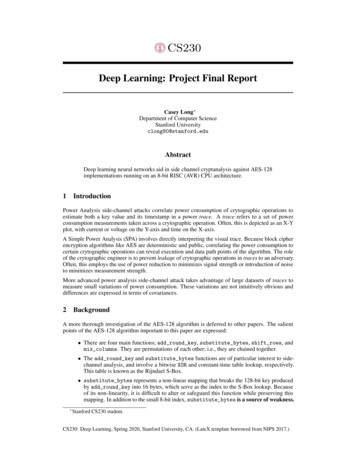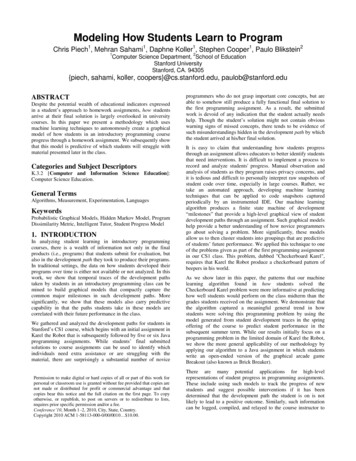
Transcription
Lecture 07: Signals"The barman asks what the firstone wants, two race conditionswalk into a bar."Principles of Computer SystemsSpring 2019Stanford UniversityComputer Science DepartmentInstructors: Chris Gregg andPhil LevisPDF of this presentation1
Lecture 07: Signals - revisiting DisneylandLast time, Phil discussed the Disneyland example, and discussed one issue with signal handling.To recap:Five kids run about Disneyland for the same amount of time. In our code, they all sleep(3)so all five children finish at a almost the same time (they are running in parallel, remember).The code is here, except sleep(3 * kid) has become sleep(3)The output presented below makes it clear dad never detects all five kids are present andaccounted for, and the program runs forever because dad keeps going back to sleep.cgregg*@myth60 ./broken-pentupletsLet my five children play while I take a nap.At least one child still playing, so dad nods off.Kid #1 done playing. runs back to dad.Kid #2 done playing. runs back to dad.Kid #3 done playing. runs back to dad.Kid #4 done playing. runs back to dad.Kid #5 done playing. runs back to dad.Dad wakes up! At least one child still playing, so dad nods off.Dad wakes up! At least one child still playing, so dad nods off.Dad wakes up! At least one child still playing, so dad nods off.Dad wakes up! At least one child still playing, so dad nods off. C # I needed to hit ctrl-c to kill the program that loops forever!cgregg@myth60 2
Lecture 07: SignalsAs Phil discussed, if multiple children finish at the same time, the signal handler is only run once.If three SIGCHLD signals are delivered while dad is off the processor, the operating systemonly records the fact that at one or more SIGCHLDs came in.When the parent is forced to execute its SIGCHLD handler, it must do so on behalf of theone or more signals that may have been delivered since the last time it was on theprocessor.That means our SIGCHLD handler needs to call waitpid and WNOHANG, in a loop, as with:static void reapChild(int unused) {while (true) {pid t pid waitpid(-1, NULL, WNOHANG);if (pid 0) break; // note the is now a numDone ;}}Now, all of the children that have stopped get cleaned up by the waitpid, and there is no blocking.You might rightly ask -- what happens if a signal comes in while the signal handler is running?This is an important question! Let's take a few minutes to think about the consequences of a signalcoming in during the reapChild function.3
Lecture 07: Signals1 static void reapChild(int unused) {2while (true) {3pid t pid waitpid(-1, NULL, WNOHANG);4if (pid 0) break;5numDone ;6}7 }Let's assume that three children finish at almost exactly the same time, and the reapChildfunction gets called.The while loop gets executed three times, to clean up the three children that triggeredSIGCHLD handler.But, what if another child finishes somewhere in the loop? The designers of Linux could havechosen to assume that waitpid will clean up after that one, as well. If that was the case, let'sfirst look at what happens if the fourth child finishes after line 5 above.The while loop will continue, and then waitpid will properly clean up after the fourth child.Yay!4
Lecture 07: Signals1 static void reapChild(int unused) {2while (true) {3pid t pid waitpid(-1, NULL, WNOHANG);4if (pid 0) break;5numDone ;6}7 }But, what happens if the fourth child ends right after line 3?In this case, the return value for waitpid will be 0 to indicate that there are still remaining children tofinish (correct at that point in time), and then proceed to line 4, which will break out of the loop, andleave the function. The fourth child would not get cleaned up.If Linux assumed that the signal handler cleaned up fourth child, this would be a bug!So, it turns out that Linux made the following decision:"When the handler for a particular signal is invoked, that signal is automatically blocked until the handlerreturns. That means that if two signals of the same kind arrive close together, the second one will be held untilthe first has been handled." (bold mine)The "close together" part is a bit confusing -- if two children finish really close together, only one signalwill be generated (and must be cleaned up as above). If a further child ends, it will generate a new signalthat will call the signal handler again, after the currently-running function ends.5
Lecture 07: Signals1 static void reapChild(int unused) {2while (true) {3pid t pid waitpid(-1, NULL, WNOHANG);4if (pid 0) break;5numDone ;6}7 }To reiterate:If one or more children end almost simultaneously, only one signal will be generated, and the childrenmust be cleaned up in a loop, as above.If another child ends while the signal handler above is running, another signal will be generated, and itwill fire after the above function ends.The function will run again, and then can properly clean up the child that just ended.As we saw, if the Linux designers had not done it this way, there could be a race condition, where we havebehavior that we cannot rely on. Race conditions crop up everywhere when writing concurrent code (i.e.,processes that run concurrently), so not only do we as programmers need to be aware of it, but we alsohave to understand how the system works so we know what we really can expect.6
Lecture 07: SignalsAll SIGCHLD handlers generally have this while loop structure.Call waitpid( 1, &status, WNOHANG)A return value of -1 typically means that there are no child processes left.A return value of 0—that's a new possible return value for us—means there are other childprocesses, and we would have normally waited for them to exit, but we’re returning insteadbecause of the WNOHANG being passed in as the third argument.The third argument supplied to waitpid can include several flags bitwise-or'ed together.WUNTRACED informs waitpid to block until some child process has either ended or beenstopped ("stopped" in this case really means "paused").WCONTINUED informs waitpid to block until some child process has either ended orresumed from a stopped state.WUNTRACED WCONTINUED WNOHANG asks that waitpid return information abouta child process that has changed state (i.e. exited, crashed, stopped, or continued) but to doso without blocking.7
Lecture 07: Masking Signals and Deferring HandlersSynchronization, multi-processing, parallelism, and concurrency.All of the above are central themes of the course, and all are difficult to master.When you introduce multiprocessing (as you do with fork) and asynchronous signalhandling (as you do with signal), concurrency issues and race conditions will creep inunless you code very, very carefully.Signal handlers and the asynchronous interrupts that come with them mean that yournormal execution flow can, in general, be interrupted at any time to handle signals.Consider the program on the next slide, which is a nod to the type of code you'll write forAssignment 4. The full program, with error checking, is right here):The program spawns off three child processes at one-second internals.Each child process prints the date and time it was spawned.The parent also maintains a pretend job list. It's pretend, because rather thanmaintaining a data structure with active process ids, we just inline printf statementsstating where pids would be added to and removed from the job list data structureinstead of actually doing it.8
Lecture 07: Masking Signals and Deferring HandlersHere is the program itself on the left, and some test runs on the right.1234567891011121314151617181920// job-list-broken.cstatic void reapProcesses(int sig) {while (true) {pid t pid waitpid(-1, NULL, WNOHANG);if (pid 0) break;printf("Job %d removed from job list.\n", pid);}}char * const kArguments[] {"date", NULL};int main(int argc, char *argv[]) {signal(SIGCHLD, reapProcesses);for (size t i 0; i 3; i ) {pid t pid fork();if (pid 0) execvp(kArguments[0], kArguments);sleep(1); // force parent off CPUprintf("Job %d added to job list.\n", pid);}return 0;}myth60 ./job-list-brokenSun Jan 27 03:57:30 PDT 2019Job 27981 removed from job list.Job 27981 added to job list.Sun Jan 27 03:57:31 PDT 2019Job 27982 removed from job list.Job 27982 added to job list.Sun Jan 27 03:57:32 PDT 2019Job 27985 removed from job list.Job 27985 added to job list.myth60 ./job-list-brokenSun Jan 27 03:59:33 PDT 2019Job 28380 removed from job list.Job 28380 added to job list.Sun Jan 27 03:59:34 PDT 2019Job 28381 removed from job list.Job 28381 added to job list.Sun Jan 27 03:59:35 PDT 2019Job 28382 removed from job list.Job 28382 added to job list.myth60 9
Lecture 07: Masking Signals and Deferring HandlersEven with a program this simple, there are implementation issues that need to be addressedThe most troubling part of the output on the right is the factthat process ids are being removed from the job list beforethey're being added.It's true that we're artificially pushing the parent off the CPUwith that sleep(1) call, which allows the child process tochurn through its date program and print the date and time tostdout.Even if the sleep(1) is removed, it's possible that the childexecutes date, exits, and forces the parent to execute itsSIGCHLD handler before the parent gets to its own printf.The fact that it's possible means we have a concurrency issue.We need some way to block reapProcesses from runninguntil it's safe or sensible to do so. Restated, we'd like topostpone reapProcesses from executing until the parent'sprintf has returned.myth60 ./job-list-brokenSun Jan 27 03:57:30 PDT 2019Job 27981 removed from job list.Job 27981 added to job list.Sun Jan 27 03:57:31 PDT 2019Job 27982 removed from job list.Job 27982 added to job list.Sun Jan 27 03:57:32 PDT 2019Job 27985 removed from job list.Job 27985 added to job list.myth60 ./job-list-brokenSun Jan 27 03:59:33 PDT 2019Job 28380 removed from job list.Job 28380 added to job list.Sun Jan 27 03:59:34 PDT 2019Job 28381 removed from job list.Job 28381 added to job list.Sun Jan 27 03:59:35 PDT 2019Job 28382 removed from job list.Job 28382 added to job list.myth60 10
Lecture 07: Masking Signals and Deferring HandlersThe kernel provides directives that allow a process to temporarily ignore signal delivery.The subset of directives that interest us are presented below:int sigemptyset(sigset t *set);int sigaddset(sigset t *additions, int signum);int sigprocmask(int how, const sigset t *set, sigset t *oldset);The sigset t type is a small primitive—usually a 32-bit, unsigned integer—that's used as abit vector of length 32. Since there are just under 32 signal types, the presence or absence ofsignums can be captured via an ordered collection of 0's and 1's.sigemptyset is used to initialize the sigset t at the supplied address to be the empty setof signals. We generally ignore the return value.sigaddset is used to ensure the supplied signal number, if not already present, gets added tothe set addressed by additions. Again, we generally ignore the return value.sigprocmask adds (if how is set to SIG BLOCK) or removes (if how is set toSIG UNBLOCK) the signals reachable from set to/from the set of signals being ignored at themoment. oldset is the location of a sigset t that can be updated with the set ofsignals being blocked at the time of the call, so you can restore it later if you need to.11
Lecture 07: Masking Signals and Deferring HandlersHere's a function that imposes a block on SIGCHLDs:static void imposeSIGCHLDBlock() {sigset t set;sigemptyset(&set);sigaddset(&set, SIGCHLD);sigprocmask(SIG BLOCK, &set, NULL);}Here's a function that lifts the block on the signals packaged within the supplied vector:static void liftSignalBlocks(const vector int & signums) {sigset t set;sigemptyset(&set);for (int signum: signums) sigaddset(&set, signum);sigprocmask(SIG UNBLOCK, &set, NULL);}Note that NULL is passed as the third argument to both sigprocmask calls. That just meansthat I don't care to hear about what signals were being blocked before the call.12
Lecture 07: Masking Signals and Deferring HandlersHere's an improved version of the job list program from earlier. (Full program here.)// job-list-fixed.cchar * const kArguments[] {"date", NULL};int main(int argc, char *argv[]) {signal(SIGCHLD, reapProcesses);sigset t set;sigemptyset(&set);sigaddset(&set, SIGCHLD);for (size t i 0; i 3; i ) {sigprocmask(SIG BLOCK, &set, NULL);pid t pid fork();if (pid 0) {sigprocmask(SIG UNBLOCK, &set, NULL);execvp(kArguments[0], kArguments);}sleep(1); // force parent off CPUprintf("Job %d added to job list.\n", pid);sigprocmask(SIG UNBLOCK, &set, NULL);}return 0;}myth60 ./job-list-fixedSun Jan 27 05:16:54 PDT 2019Job 3522 added to job list.Job 3522 removed from job list.Sun Jan 27 05:16:55 PDT 2019Job 3524 added to job list.Job 3524 removed from job list.Sun Jan 27 05:16:56 PDT 2019Job 3527 added to job list.Job 3527 removed from job list.myth60 ./job-list-fixedSun Jan 27 05:17:15 PDT 2018Job 4677 added to job list.Job 4677 removed from job list.Sun Jan 27 05:17:16 PDT 2018Job 4691 added to job list.Job 4691 removed from job list.Sun Jan 27 05:17:17 PDT 2018Job 4692 added to job list.Job 4692 removed from job list.myth60 13
Lecture 07: Masking Signals and Deferring HandlersThe program on the previous page addresses all of our concurrency concernsThe implementation of reapProcesses is the same as before,so I didn't reproduce it.The updated parent programmatically defers its obligation tohandle signals until it returns from its printf—that is, it's addedthe pid to the job list.As it turns out, a forked process inherits blocked signal sets, so itneeds to lift the block via its own call tosigprocmask(SIG UNBLOCK, .). While it doesn't matterfor this example (date almost certainly doesn't spawn its ownchildren or rely on SIGCHLD signals), other executables may verywell rely on SIGCHLD, as signal blocks are retained even acrossexecvp boundaries.In general, you want the stretch of time that signals are blocked tobe as narrow as possible, since you're overriding default signalhandling behavior and want to do that as infrequently as possible.myth60 ./job-list-fixedSun Jan 27 05:16:54 PDT 2019Job 3522 added to job list.Job 3522 removed from job list.Sun Jan 27 05:16:55 PDT 2019Job 3524 added to job list.Job 3524 removed from job list.Sun Jan 27 05:16:56 PDT 2019Job 3527 added to job list.Job 3527 removed from job list.myth60 ./job-list-fixedSun Jan 27 05:17:15 PDT 2018Job 4677 added to job list.Job 4677 removed from job list.Sun Jan 27 05:17:16 PDT 2018Job 4691 added to job list.Job 4691 removed from job list.Sun Jan 27 05:17:17 PDT 2018Job 4692 added to job list.Job 4692 removed from job list.myth60 14
Lecture 07: Masking Signals and Deferring HandlersSignal extras: kill and raiseProcesses can message other processes using signals via the kill system call. And processescan even send themselves signals using raise.int kill(pid t pid, int signum);int raise(int signum); // equivalent to kill(getpid(), signum);The kill system call is analogous to the /bin/kill shell command.Unfortunately named, since kill implies SIGKILL implies death.So named, because the default action of most signals in early UNIX implementations was tojust terminate the target process.We generally ignore the return value of kill and raise. Just make sure you call it properly.The pid parameter is overloaded to provide more flexible signaling.When pid is a positive number, the target is the process with that pid.When pid is a negative number less than -1, the targets are all processes within the processgroup abs(pid). We'll rely on this in Assignment 4.pid can also be 0 or -1, but we don't need to worry about those. See the man page forkill if you're curious.15
Lecture 07: A more sophisticated shell (but not quite right yet.)Last week, we looked at mysystem, which was a very simple shell that allowed us to run commands: ./simpleshsimplesh ls -l five-children.c-rw------- 1 cgregg operator 1670 Sep 23 09:29 five-children.csimplesh dateWed Oct 9 09:48:14 PDT 2019simplesh Now, let's look at a more sophisticated program, simplesh , which will allow us to run programs inthe background as well as in the foreground.simplesh operates as a read-eval-print loop—often called a repl—which itself responds to themany things we type in by forking off child processes.Each child process is initially a deep clone of the simplesh process.Each proceeds to replace its own process image with the new one we specify, e.g. ls, cp, our ownCS110 search (which we wrote during our second lecture), or even emacs.As with traditional shells, a trailing ampersand—e.g. as with emacs &—is an instruction toexecute the new process in the background without forcing the shell to wait for it to finish.Implementation of simplesh is presented on the next slide. Where helper functions don't rely onCS110 concepts, I omit their implementations.16
Lecture 07: A more sophisticated shell (but not quite right yet.)Here's the core implementation of simplesh (full implementation is right here, and you canrun the code on the following slide):1 int main(int argc, char *argv[]) {2while (true) {3char command[kMaxCommandLength 1];4readCommand(command, kMaxCommandLength);5char *arguments[kMaxArgumentCount 1];6int count parseCommandLine(command, arguments, kMaxArgumentCount);7if (count 0) continue;8if (strcmp(arguments[0], "quit") ) break; // hardcoded builtin to exit shell9bool isbg strcmp(arguments[count - 1], "&") 0;10if (isbg) arguments[--count] NULL; // overwrite "&"11pid t pid fork();12if (pid 0) execvp(arguments[0], arguments);13if (isbg) { // background process, don't wait for child to finish14printf("%d %s\n", pid, command);15} else {// otherwise block until child process is complete16waitpid(pid, NULL, 0);17}18}19printf("\n");20return 0;21 }17
Lecture 07: A more sophisticated shell (but not quite right yet.)https://cplayground.com/embed?p fox-chimpanzee-hawk18
Lecture 07: A more sophisticated shell (but not quite right yet.)int main(int argc, char *argv[]) {while (true) {char command[kMaxCommandLength 1];readCommand(command, kMaxCommandLength);char *arguments[kMaxArgumentCount 1];int count parseCommandLine(command, arguments, kMaxArgumentCount);if (count 0) continue;if (strcmp(arguments[0], "quit") ) break; // hardcoded builtin to exit shellbool isbg strcmp(arguments[count - 1], "&") 0;if (isbg) arguments[--count] NULL; // overwrite "&"pid t pid fork();if (pid 0) execvp(arguments[0], arguments);if (isbg) { // background process, don't wait for child to finishprintf("%d %s\n", pid, command);} else {// otherwise block until child process is completewaitpid(pid, NULL, 0);}}printf("\n");return 0;}What is the main issue with our simplesh?19
Lecture 07: A more sophisticated shell (but not quite right yet.)int main(int argc, char *argv[]) {while (true) {char command[kMaxCommandLength 1];readCommand(command, kMaxCommandLength);char *arguments[kMaxArgumentCount 1];int count parseCommandLine(command, arguments, kMaxArgumentCount);if (count 0) continue;if (strcmp(arguments[0], "quit") ) break; // hardcoded builtin to exit shellbool isbg strcmp(arguments[count - 1], "&") 0;if (isbg) arguments[--count] NULL; // overwrite "&"pid t pid fork();if (pid 0) execvp(arguments[0], arguments);if (isbg) { // background process, don't wait for child to finishprintf("%d %s\n", pid, command);} else {// otherwise block until child process is completewaitpid(pid, NULL, 0);}}printf("\n");return 0;}What is the main issue with our simplesh?Background processes are left as zombies for the lifetime of the shell!We can handle this with signal handling.20
Lecture 07: A more sophisticated shell (but not quite right yet.)Now we know about SIGCHLD signals and how to install SIGCHLD handlers to reap zombieprocesses. Let's upgrade our simplesh implementation to reap all process / simplesh-with-redundancy.cstatic void reapProcesses(int sig) {while (waitpid(-1, NULL, WNOHANG) 0) {;} // nonblocking, iterate until retval is -1 or 0}int main(int argc, char *argv[]) {signal(SIGCHLD, reapProcesses);while (true) {// code to initialize command, argv, and isbg omitted for brevitypid t pid fork();if (pid 0) {execvp(argv[0], argv);printf("%s: Command not found\n", argv[0]);exit(0);}if (isbg) {printf("%d %s\n", pid, command);} else {waitpid(pid, NULL, 0);}}printf("\n");return 0;}21
Lecture 07: A more sophisticated shell (but not quite right yet.)The last version actually works, but it relies on a sketchy call to waitpid to halt the shell until itsforeground process has exited.When the user creates a foreground process, normal execution flow advances to an isolated waitpidcall to block until that process has terminated.When the foreground process finishes, however, the SIGCHLD handler is invoked, and its waitpidcall is the one that culls the foreground process's resources.When the SIGCHLD handler exits, normal execution resumes, and the original call to waitpidreturns -1 to state that there is no trace of a process with the supplied pid.The version on the last slide deck is effectively calling waitpid from main just to block until theforeground process vanishes.Even if you're content with this unorthodox use of waitpid—i.e. invoking a system call when youknow it will fail—the waitpid call is redundant and replicates functionality better managed in theSIGCHLD handler.We should only be calling waitpid in one place: the SIGCHLD handler.This will be all the more apparent when we implement shells (e.g. Assignment 4's stsh) wheremultiple processes are running in the foreground as part of a pipeline (e.g.more words.txt tee copy.txt sort uniq)22
Lecture 07: A more sophisticated shell (but not quite right yet.)Here's an updated version that's careful to call waitpid from only one 7282930// simplesh-with-race-and-spin.cstatic pid t fgpid 0; // global, intially 0, and 0 means no foreground processstatic void reapProcesses(int sig) {while (true) {pid t pid waitpid(-1, NULL, WNOHANG);if (pid 0) break;if (pid fgpid) fgpid 0; // clear foreground process}}static void waitForForegroundProcess(pid t pid) {fgpid pid;while (fgpid pid) {;}}int main(int argc, char *argv[]) {signal(SIGCHLD, reapProcesses);while (true) {// code to initialize command, argv, and isbg omitted for brevitypid t pid fork();if (pid 0) execvp(argv[0], argv);if (isbg) {printf("%d %s\n", pid, command);} else rn 0;}23
Lecture 07: A more sophisticated shell (but not quite right yet.)The version on the last page introduces a global variable called fgpid to hold the process is of theforeground process. When there's no foreground process, fgpid is 0.Because we don't control the signature of reapProcesses, we have to choice but to make fgpid aglobal.Every time a new foreground process is created, fgpid is set to hold that process's pid. The shell thenblocks by spinning in place until fgpid is cleared by reapProcesses.This version consolidates the waitpid code to reside in the handler and nowhere else.This version introduces two serious problems, so it's far from an A solution.It's possible the foreground process finishes and reapProcesses is invoked on its behalf beforenormal execution flow updates fgpid. If that happens, the shell will spin forever and never advance upto the shell prompt. This is a race condition, and race conditions are no-nos.The while (fgpid pid) {;} is also a no-no. This allows the shell to spin on the CPU evenwhen it can't do any meaningful work.It would be substantially better for simplesh to yield the CPU and to only be considered for CPUtime when there's a chance the foreground process has exited.24
Phil Levis PDF of this presentation "The barman asks what the first one wants, two race conditions walk into a bar." 1. Last time, Phil discussed the Disne yland example, and discussed one issue with signal handling. To recap: Five kids run about Disne yland for the same amount of time. In our code, the y all sleep(3)




